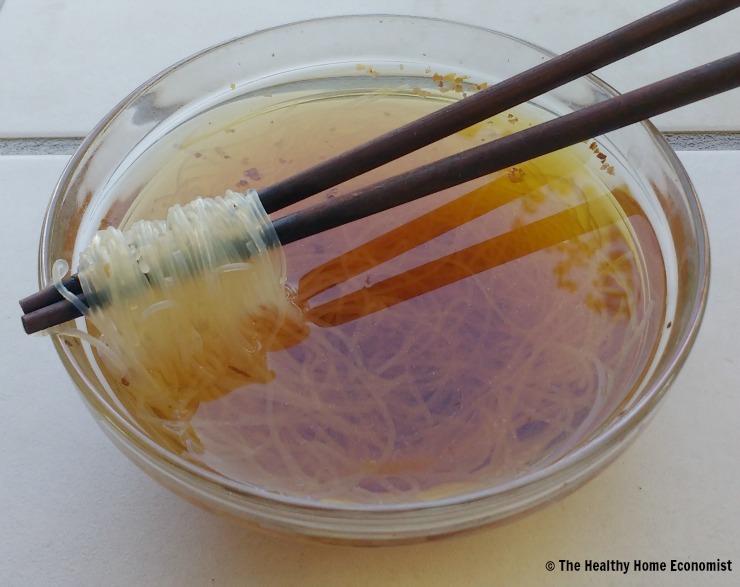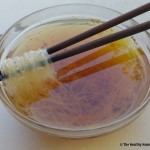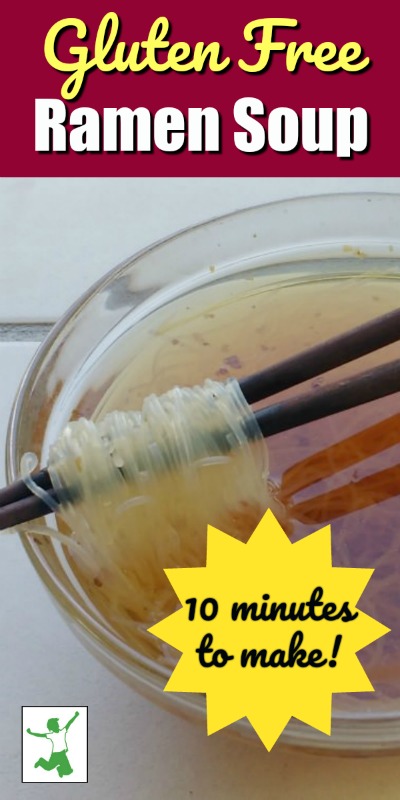Table of Contents[Hide][Show]
A healthy, gluten-free ramen soup to enjoy instead of commercially packaged versions that are fried and contain MSG and sugar.
I’ve written before about how I ate packaged ramen noodle soup in college several times a week. Easy to prepare, filling, and cheap at only about 10 cents per serving, the attractive little packages represent the ultimate low budget food. Little did I know that the 20 pounds I gained my first year away from home likely stemmed from eating so many cheap carbs.
In the ensuing years, I realized the benefits of bone broth over packaged ramen and canned soup and made the switch permanently. However, I still enjoy a bowl of noodles every now and then. While I prepare them much the same, I more carefully vet the ingredients!
The Problem with Commercial Ramen Soup
The main issue with factory-produced ramen noodle soup brands is that the processing involves flash-frying the cooked noodles. A few brands apparently air dry the noodle blocks. However, the consumer must take the time to contact the manufacturer to determine which processing method was used. Not many folks will bother to do that!
Even if the ramen noodles were not fried, the seasoning packet contains a large amount of MSG and even sugar. Research on rats demonstrated that excessive MSG consumption causes blindness and obesity. Studies on mice demonstrated that MSG intake caused brain lesions on the hypothalamus, the master controller of the endocrine system (1).
In addition, the peer-reviewed Journal of Nutrition published a study in 2014 warning that those who consume ramen noodles as little as two times per week are at skyrocketing odds of developing metabolic syndrome with its host of prominent symptoms: obesity (particularly excess abdominal fat), diabetes, heart disease, and stroke (2).
A total of 10,711 adults (54.5% women) ages 19-64 years of age were analyzed, with adjustment for sampling design complexity. The diet of the study participants was assessed by using a 63-item food-frequency questionnaire.
How Commercial Ramen Harms Health
Head researcher Hyun Joon Shin MD, a clinical cardiology fellow at Baylor University and a nutrition epidemiology PhD from the Harvard School of Public Health and his team uncovered a disturbing association between eating instant noodles two or more times a week and development of cardiometabolic syndrome. This condition raises a person’s likelihood, particularly if that person is female, of developing heart disease and other metabolic health woes.
Another potential problem with consuming commercial ramen noodles is the chemical called bisphenol A (BPA). Food manufacturers use these chemical for packaging some ramen noodles brands. Studies have shown that BPA is an estrogen mimicker and endocrine disruptor. It interferes with hormone messaging within the body. BPA free packaging is likely no safeguard! The reason is that the chemicals that replace BPA in food packaging like BPS have the same and perhaps even worse hormone disrupting effects.
If you love ramen soup and wish to avoid the health problems associated with consuming it regularly, try this homemade version instead. It can give you a hot bowl of tasty instant noodles fast without the MSG, sugar, or cardiovascular risks!
Ramen Soup (healthy, homemade and gluten free)
I hope you enjoy the ramen soup recipe below made with fermented miso as the base. There is no reason not to enjoy ramen as long as you make it yourself with quality ingredients!

Healthy Ramen Soup Recipe (no MSG)
Easy ramen soup recipe that is gluten free too!
Ingredients
- 1 oz (28 grams) rice noodles
- 1.5 cups filtered water or bonito broth
- 1 Tbl miso paste preferably organic and unpasteurized
- 1 tsp wakame
- soy sauce preferably unpasteurized, organic, and traditionally brewed
Instructions
-
Put wakame or kelp flakes in a cup and fill with cold, filtered water. Set aside.
-
Place noodles in a bowl and pour 1.5 cups boiling water (or bonito broth) on top. Let sit for 5 minutes.
-
Drain the water from the cup of soaking wakame or kelp flakes and stir the softened bits of seaweed into the bowl of noodles.
-
Stir in the miso and season to taste with soy sauce.
-
Serve your bowl of ramen soup with a salad or a sandwich and lunch is ready in less than 10 minutes!
Recipe Notes
Mung bean pasta can be used instead of rice noodles.
Fish sauce or coconut aminos may be substituted for soy sauce for those with a soy or wheat sensitivity or allergy.
The miso is not stirred into the bowl of noodles immediately to ensure that the enzymes and probiotics from the unpasteurized miso paste are preserved.









Jeff, YOU have not done your homework; however, there is a lot of misinformation about MSG out there, so it is understandable.
First of all, MSG is highly neuro-toxic. Secondly, the food industry HIDES its presence in processed foods by no longer using the term “MSG;” instead “processed free glutamic acid” (the correct, non-proprietary term) is hidden in 50+ common ingredients. Thirdly, your generic search term was very likely to reveal answers which are crafted by the PR arm of the glutamate industry; they fully expect to allay the fears of readers who do quick, instant-searches, by flooding the internet with PR & false data about their neuro-toxic product.
See: Truth in Labeling and the work of Jack & Dr. Adrienne Samuels; Dr. Katherine Reid at Unblind My Mind; Dr. Russell Blaylock who wrote THE book on MSG, “Excitotoxins: The Taste That Kills;”Debby Anglesey’s Battling the MSG Myth; Carol Hoernlein’s MSG Truth; Say No to MSG; Dr. Amy Yasko’s “Detecting Neuro-Provoking Foods” and “The Role of Excitotoxins in Autistic Behavior;” John and T. Michelle Erb’s “The Slow Poisoning of America;” George R. Schwartz, M.D., “In Bad Taste: The MSG Symptom Complex;” and Natural News’ Mike Adams, “The Truth About Aspartame, MSG and Excitotoxins: An interview with Dr. Russell Blaylock.”
Also , try using the search terms “processed free glutamic acid” and “toxic” or “neurotoxic” or “cancer causing” or “diabetes” or “Alzheimer’s.” It will take you a while to digest all of that scientific data about the neuro-toxicity of “processed free glutamic acid,” which the food industry used to call MSG and which it now refers to – in its marketing of that ingredient – as “savory ingredient” or “Umami flavor.”
Why does the processed food industry work so devilishly hard to HIDE MSG in its foods? If it’s so good for you, why not simply advertise its presence? Could it be that they KNOW it’s poisonous? Could it be that they also know it’s addictive and they have found THE PERFECT, SECRET MEANS by which to hook us all on foods that are really, really bad for us… …and good for their bottom line?
If Ramen noodles is so bad why have they allowed it to stay for sale as you say it is killing people?
LOL. The same reason McDonald’s is still in business.
Before I even knew what MSG was, it was triggering asthma attacks in myself, so I’ve basically been my own lab rat for this research. Also, family members who have high blood pressure (I do not have high blood pressure) have had serious issues as well, like passing out after eating food that they later discovered had MSG. So it seems pretty ridiculous to ignore experience because someone ELSE read something that claims what I’ve experienced is not true. So believe what is convenient for you. People will typically believe something because they are afraid it’s true, or really want it to be true. Thank you Terry Goodkind for penning that line. I like to learn the facts, otherwise I’m quickly running out of things to eat because of rampant food allergies.
While all the information on the negatives of instant ramen are great, your replacement recipe is not anything close to what ramen actually is. Your recipe is actually closer to pho than anything else. Ramen will always have the “curly” ramen noodles as this is the type of noodle required.
Personally I have been using raw Sea Tangle as pasta. It has a perfect al dente snap to it. I buy it online from Natural Zing.
Yes, I’ve been wondering about kelp noodles. I used to buy the yam noodles but I was thinking the kelp noodles might be healthier. Thoughts?
Kelp noodles are awesome! Thanks for sharing that idea.
Traditionally, ramen, which is a Japanese word and refers to one of many types of a noodle-in-soup dishes consumed in Japan, comes with array of toppings including vegetables and sea weed. Your picture does not only not resemble the ramen at all, but also seems very devoid of anything healthy and nutritionally worthy to consume. It seems not quite in sync with the theme and spirit of your website. I would strongly recommend changing the picture so that it is less misguiding and more intellectually and gastrointestinal appetizing.
Just stumbled across this blog and it looks pretty interesting. I am a little concerned though with the material on MSG in this post.
There’s surely a lot of science involved in determining how foods combine and cook, and what effects they have on your health. On top of that, most people have a very poor understanding of the scientific method, and are not very picky about references — they will just read something and believe it if it seems reasonable, or is stated authoritatively. As such, it’s quite easy to fool most people with unsubstantiated claims and poor quality science, and happens with a tragic frequency across the internet.
Honestly it’s quite difficult to properly research whether any particular food is “good” or “bad” for you. MSG, however, is quite an easy one to research, and it’s quite clear that modern science indicates that it is not bad for you. My research on the topic was quite simple. I just googled “is MSG unhealthy?”, and all of the results concluded that it is not, and explained in detail why. I won’t even link any of them here, you can find them yourself in a moment.
I appreciate for sure that you took the time to find a supporting study and cite it — this is farther than most blogs will go when making claims about health. But even just ten seconds of research would have shown that, regardless of the studies on rats, MSG doesn’t have any negative health benefits for humans. You also don’t reference a scientific stud directly, but rather a 14 year old article that then references a scientifically inaccurate study from 1957, almost 60 years old.
While I’m here, why not talk about the BPA claims. While it is true that BPA is considered harmful when consumed, the evidence you present for the presence of BPA in ramen packaging is nonexistent. Where did you find this information? And is it just ramen, or all plastic packaging, such as, say, the packing of the rice noodles you suggest for this recipe, that contain BPA? And where’s the citation on your claim about BPA being an estrogen mimic, and on BPA-free packaging still containing harmful chemicals? These would be very easy citations to grab, you can find this info all over the internet.
It may well be the case that I’m just a weirdo for calling you out on this stuff, but putting in the extra effort to really thoroughly research the scientific implications of posts is super important. I subscribed to this blog initially after reading a couple good posts, but then after seeing a few lacking citations and/or making incorrect scientific claims, I’m starting to doubt whether I can trust you : (
You need to do additional research … it seems you are confusing natural glutamate in food which is NOT the same as synthetically derived MSG added to processed foods to make them palatable. And, synthetic MSG is most definitely bad for you! I would direct you to the book “Excitotoxins” by neurologist Dr. Russell Blaylock who outlines research where MSG kills neurons in the brain which apparently never fully recover.
You need to do more than Google MSG! T processed food companies are most likely responsible for the mis-information about MSG. Read Laura’s post 1/25/2019. She has cited many references that will give you accurate information on MSG. A basic book is “In bad taste, the MSG Syndrome.
Hi Pam, there is a frequent mistake made that natural glutamate and MSG are the same thing. They are NOT. It is similar to the differences between synthetic vitamins and natural vitamins. MSG is the synthetic version of glutamate … it is the mirror image molecularly and damages the brain unlike glutamate which the brain needs.
By the way, if you are googling for this info, note that this search engine puts the tainted science at the top and promotes the false narrative about MSG.
i am a big fan of Ramen, on top of it yummy mung bean noodles… will surely try this. thanks for sharing the recipe.
I make something really similar, and you’re right – it’s a great quick meal. Try starting with a simple bonito broth and keep the rest the same. Great flavour, and it only adds a couple minutes!
Great idea! Bonita broth would make an excellent base for this soup too. I think I will add that as an option in the post.
I just made this because my tummy has been off. When I feel better I am going to add green onions and maybe a little finely shredded carrot. It was delicious. Thank you!
A good soup to make on those nights when oops you are out of bone broth. Glad you liked it!
Yes, Laurie!
I take my broth (homemade Dashu or dashu powder), add a tiny bit of fish sauce, then whisk eggs and make **Egg drop soup*, finely shredded carrots, not too much, though, some ginger and Chinese 5 spice (I know, Japanese, but still has the flavor), My homemade Umami Sauce which contains the flavor of lots of homemade Asian sauces together, toasted Sesame oil and chive rings. As well, leave the miso until the soup has been removed from the heat…
Great recipe!
I also use low carb noodles, but that’s just me. Konjac noodles or egg white noodles don’t have the same texture, so I do use a low carb flour noodle.